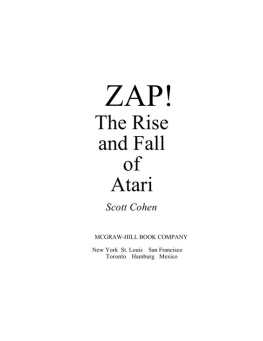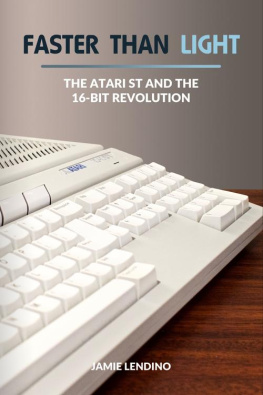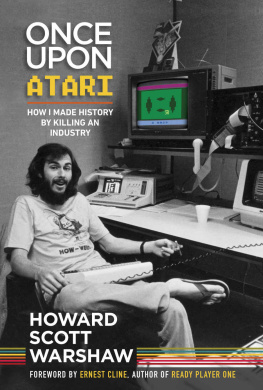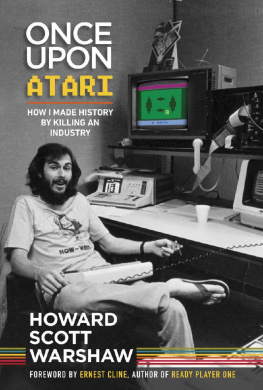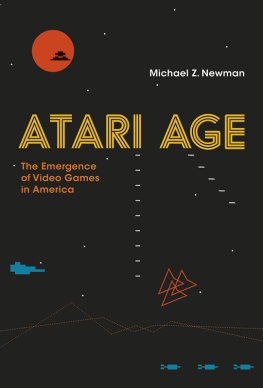ZAP!
The Rise
and Fall
of
Atari
Scott Cohen
MCGRAW-HILL BOOK COMPANY
New York St. Louis
San Francisco
Toronto
Hamburg Mexico
Copyright 1984 by Scott Cohen
All rights reserved. Printed in the United States of America. Except as permitted under the Copyright Act of 1976, no part of this publication may be reproduced or distributed in any form or by any means or stored in a data base or retrieval system, without the prior written permission of the publisher.
1 2 3 4 5 6 7 8 9 FGR FGR 8 7 6 5 4
ISBN 0-07-011543-5
Library of Congress Cataloging in Publication Data Cohen, Scott
ZAP! the rise sod fall of Atari.
1. Atari, Inc.--History. 2. Electronic games
industry--United States --History. I. Title.
HD9993.E454A853 1984
338.4'7794
83-22 198
ISBN 0-07-011543-5
Book Design by Nancy Dale Muldoon
FOR GILBO
THE AUTHOR would like to thank Gordon Bishop, Susan Blond, Boom Boom, Ernie Brooks, Suzie Crocker, Jack Freeman, Gail Greene, Lisa Grotheer, Robert Hicks, Danny Himmelfarb, Gary Kenton, Huey Lewis, Susan Lee Merrow, Glenn O'Brien, Richard Pine, Michael Rosenberg, Kathleen Stein, Stephanie, and a number of people who provided inside information and would rather not be mentioned by name.
Special thanks to David Cohen.
"The total amount requested for aid to all of Central America in 1984 is about $600 million; that is less than one-tenth of what Americans will spend this year on Coin-operated video games..."
--from the President's speech to Congress
Author's Note
"THEY have seen our demise and named it Atari," declared Clive Davis, president of Arista Records, in a Billboard magazine editorial. He was responding to fearful Comments by industry biggies that video games meant "the end of recorded music as we know it."
Davis admitted video games were hot. "Certainly we're competing for that lunch money, for those allowances, but to think these games will supplant music is absurd." He wound up by saying, "You can't hum a video game or dance to its beat."
Of course Clive Davis was wrong. People could dance to it, to the tune of billions of dollars a year. In 1981 alone, five billion dollars and seventy-five thousand man-years were spent at video machines and a billion dollars more were spent on home video game entertainment. That's twice the amount reported that year by all the Casinos in Las Vegas combined. Video games raked in almost twice what Hollywood grossed; three times the combined TV revenues and gate receipts of major-league baseball, basketball and football; and four times the amount of money spent on records and rock concerts. People hummed along, tapped their toes, bobbed their heads and shook their hips to the video beat, but they couldn't snap their fingers to it--they were too busy pushing buttons.
I've seen the best minds--and feet--of my generation destroyed in arcades, bowling alleys, pizza parlors, candy stores, five-and-dimes, and 7-Elevens. I've watched lunchless teens throw away their allowances on Space Invaders; grown men in suits and ties tear their hair out and cry over Asteroids; Pac-maniacs crawl through the streets at dawn looking for a video fix. I've seen homes broken, marriages ruined, careers destroyed by video games. An 18-year-old was murdered in a bar on Long Island over a game of Pac-man. Another player in Illinois died of a heart attack while playing Berserk. I'd seen these vidiots waste their money and their lives, and I wanted to meet the inventors of these games. In 1982, I flew out to Silicon Valley (California), "the cradle of electronic civilization," to visit Atari, once the fastest-growing company in the history of the country. The following is a modern fable, as related by those who were there, about a company that went from $0 to $2 billion in ten years and then blew it in less than a year.
FROM THE AIR, Silicon Valley, with its gridlike streets, low, rectangular buildings, and identical rows of industrial parks, looks like a giant microchip.
Buildings look like transistors, parking lots like resistors, and the on-and-off ramps of the freeway that connect the Valley with the outside world look like the lands around the edges of the microchip. Moffett Field blimp hangar, the largest landmark in the Valley, could easily be taken for an ROM, an array of memory cells that form the largest landmark on the chip, except you need a microscope to see it.
Silicon Valley begins in Palo Alto, at Bill Hewlett's garage, where in 1939 he and Dave Packard, a fellow Stanford alumnus, launched Hewlett-Packard, the highly regarded, multibillion-dollar granddaddy of electronics firms. From there it sprawls south for about twenty miles, to San Jose, taking in a dozen towns along the way. Every day another chip manufacturer, supplier, or chip-related company pops up, making the Valley the world's semiconductor capital, just as Castroville, to the southwest, is the artichoke capital. Until the mid-1950s the fertile Santa Clara Valley, as it is formally called, was a veritable fruit bowl-acres upon acres of apricot, cherry, pear, and plum orchards; half the world's prunes came from here. Today, of the original hundred thousand acres of orchards, only thirteen hundred remain. It's as if an engineer in the mountains had pushed a button and We prunes had turned into microchips.
W h i z - k i d e n g i n e e r s , h o t p r o g r a m m e r s , m a v e r i c k e n t r e p r e n e u r s , headhunters, venture capitalists, and industrial spies come to the Valley in droves.
They know it's not unusual to land a job one day and start a new business the next, taking along company secrets, a few employee buddies, and maybe some equipment. They know technology is evolving so fast here that any self-starting, fast-moving, money-grubbing egomaniac with the right idea at the right time can wind up filthy rich. Most put in twelve-hour days, seven days a week, for months and end up depressed, divorced, and drunk, just like the prospectors of California's first Gold Rush.
*
*
*
Fog doesn't roll into the Valley the way it rolls into San Francisco. Smog from San Francisco and Oakland blows through on its way to San Jose. The air is dusty and yellow, especially in the summer, and the barren, parched foothills to the east look like big baked potatoes that rolled down from Idaho. Their size and prehistoric topography offer a striking contrast to the low, flat, regular patterns of industrial parks spread out like a checkered tablecloth below them. The streets look like they were stamped out by a huge waffle iron. The fruit trees, knocked down by bulldozers, have been replaced by prefabricated industrial plants--no pun intended.
Most buildings around here are called "tilt-ups." They're ideal for the startup companies that occupy them. One day a helicopter flies in, puts up the walls and the roof, and the next day a company moves in, sometimes before the landscaper puts in the shrubbery. From the outside it's impossible to tell what's going on inside these buildings, one indistinguishable from another. The nameplates out front don't give a clue--Xicor, Qume, Zylog... Driving around the Valley is like driving around Beverly Hills and coming upon the homes of the stars. There's Pickfair Manor, there's Cary Grant's mansion, here's where Pat Boone lives.
There's National Semiconductor, there's Control Data, here's Intel. If it weren't for the nameplates, it would be hard to pick out Atari without putting your ear to the wall. Then you would hear that familiar thumping, bumping, and beeping coming from inside.
*
*
*
The busiest intersection in the Valley is at the corner of San Antonio and El Camino Real, in Mountain View. There are four shopping centers--four immense shopping centers--at this intersection. On the southeast corner is Avcar, a warehouse-size liquor store where customers wheel around enormous carts--the type they use in factories to move pieces of sheet metal--and fill them with half-gallon bottles of no-frills vodka. At six dollars a bottle, the bottles dance off the shelves. Beer and soda, which customers fetch themselves, are kept in walk-in refrigerators. In exchange for a discount, customers would unload a delivery, which they practically do anyway, to get to the liquor quicker. The only thing the customers don't do--and you have to admire their restraint--is drink the stuff on the spot.
Next page
